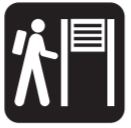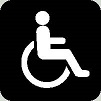Outdoor Developed Areas: A Summary of Accessibility Standards for Federal Outdoor Developed Areas
Trailhead Information Signs [F216.13 and 1017.10]

All hikers need trail information to make informed decisions. For example, hikers want to know which trail is most appropriate for the amount of time they have available, the people in their group, and the type of hike that best suits their needs or desires. Information about the accessibility of a trail enables people with disabilities to decide whether the characteristics of the trail are suited to their abilities. When this information is available on Web sites and in printed materials, it allows all hikers, including people with disabilities, the opportunity to understand the possible challenges of the trail before arriving at the trailhead.
When a new trail information sign is provided at the trailhead on a newly constructed or altered trail designed for use by hikers or pedestrians, the sign must provide information about the accessible characteristics of the trail. This requirement applies to new trailhead information signs regardless of whether the newly constructed or altered trail complies with the technical requirements for trails.
The new trail information signs must include the following information:
-
Length of the trail or trail segment
-
Type of trail surface
-
Typical and minimum trail tread width
-
Typical and maximum trail grade
-
Typical and maximum trail cross slope
Signs can provide additional information to help people with disabilities decide whether or not to attempt a trail. For example, information about the height of any major obstacles, such as boulders in the trail tread, can help people determine if they can overcome these barriers. It is helpful to have a caution notice indicating that the posted information reflects the condition of the trail when it was constructed or assessed and on what date the information was current. Because conditions in the outdoors are subject to change, knowing when an assessment was made is very helpful.

International Symbol of Accessibility (ISA)
The ISA is not required or encouraged on trail information signs.
Section F216.2 of the ABA Standards requires exterior signs that identify spaces by name to comply with the technical requirements for visual characters in section 703.5 of the ABA Standards, including the provisions for contrast of the characters and their background, and character size and style. Consequently, if a trail information sign identifies the name of the trail, the name of the trail must comply with the technical requirements for visual characters in section 703.5 of the ABA Standards. Tactile characters, Braille, and the International Symbol of Accessibility are not required on trail information signs.
Section F205 of the ABA Standards requires operable parts in accessible spaces to comply with the technical requirements for operable parts in section 309 of the ABA Standards, including the provisions for clear ground space, reach ranges, and operation. Consequently, if bins or holders for materials, such as maps, brochures, or fee envelopes, are provided at trailheads, a clear ground space at least 30 by 48 inches must be provided at the bins or holders. The bins or holders must be located a minimum of 15 inches and a maximum of 48 inches above the ground surface. If a latch or lid is provided, it must be operable using one hand without tightly grasping, pinching, or twisting the wrist.

User Comments/Questions
Add Comment/Question